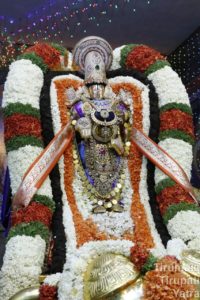Table of Contents
ToggleGlory of Brahmotsavams of Lord Sri Venkateswara
Brahma and the other Gods reached Venkatadri in search of the Lord who left Vaikunta for the welfare of the worlds and made it his abode. They saw the God and felt happy. God Brahma saluted Vishnu who incarnated himself on Narayanagiri for the welfare of humanity and to relieve human devotees from earthly bonds:
O the consort of Sri! I want to celebrate a great festival in your honor, preceded by Dhwajarohana (the installation of the flag post). Please grace the occasion with Goddess Lakshmi, Lakshmi Narayana accepted his request. Thus the Brahmotsava began with the approval of Lord Srinivasa.
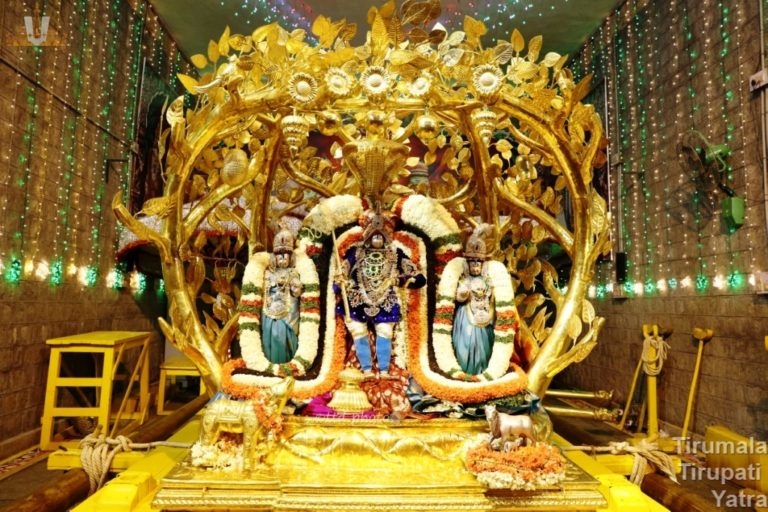
The Definition of Brahmotsava
Thus Brahma the creator, with the sun then transiting Virgo (Kanya), the month of Aswayuja as per the Chandramana (the Lunar Calender), fixing Avabhritha (Chakrasnana or the holy dip of the disc) in star sravana, the star of Srimannarayana’s incarnation, having invited divine sages like Vaikhanasa, Bhrigu, and Maricha, as its priests (ritviks), on Suklapaksha vidiya in Hastha nakshathra, with a preceding Dhwajarohana, celebrated the great festival for nine days. That was the foundation of today’s Brahmotsava.
The Brahmotsava is the great festival performed for that parabrahman. As this festival isinitiated by Brahma, it is called Brahmotsava.To show that even to date the Brahmotsavas of Lord Venkateswara are performed under the leadership of Brahma, the chariots either during the day or night, follow a small chariot, gorgeously decorated, the Brahmaratha.
The Nine-day Festival
- Navamam, Navaratnam, Brahma, Kamalasana, Nidhih, Grahah, Khanda, Randhra, Bhava and Labdhakah
These ten are the names of number nine. In the Dictionary of symbols, the name Brahma indicates nine Brahmas and thereby, the number nine.
The festival celebrated by Brahma in the name of Sri Venkateswara went on for nine days, from Dhwajarohana to Dhwajavarohana. So the name of Brahmotsava is appropriate for the grand festival that goes on for nine days.
Besides the annual Brahmotsava, there are three more Brahmotsavas that take a day each-Arsha on Rathasaptami, Rakshasa on Kaisika Dwadasi and Daivika on Mukkoti Ekadasi, all of which are celebrated in Tirumala.
All the streets around the temple of Tirumala were beautifully decorated with flags, gem-studded festoons, flower garlands and plantain trees. God Srinivasa was the cynosure of every eye, strolling on the streets of Tirumala with Sridevi and Bhudevi.
He showered his blessings on all the devotees, both human and divine, who went there to witness the great festival.
"Srinivasotsavadinam punyam papapranasanam" - "The day of Srinivasa’s festival dispels sins and showers blessings on all" – so saying, the pilgrims praised Brahma who organized the festival.
O God, please stay here on this Venkatachala so that all may witness you. Allow a festival like this, to be celebrated, annually
“Those who earnestly offer food, clothes, money, houses or utensils to the deserving and the devotees during the yajna called Brahmotsava (ut + sava = utsava) will be blessed and will prosper in life with riches and happiness”. So saying, Srinivasa asked Brahma to wish for a boon.
Brahma saluted Srinivasa and prayed to him,” O God, please stay here on this Venkatachala so that all may witness you. Allow a festival like this, to be celebrated, annually.
Protect everyone with your mercy, showering boons and blessings on all. Grant me this, my wish”. Srinivasa consented and granted him the boon. “Brahma, I will stay on Venkatadri as you wish, appear to the people and protect them all with my mercy, confer on them prosperity and happiness”. True to his word, Srinivasa (Venkateswara), the boon - giver will stay till the epoch of Kali (Kaliyuga), till the end of the Sweta Varaha Kalpa on Venkatadri.
Today, the annual Brahmotsavas in Tirumala are celebrated for nine days during the month of Kanya. But, whenever there is an extra month (Adhika Masa) as per the Chandramana, two Brahmotsavas are being celebrated.
Cars/ Vahanams
From the night after Dhwajarohana, everyday and every night festivals and processions follow with great splendor for nine days on many cars, while Malayappa swamy is accompanied by Sridevi and Bhudevi.
If some are prohibited for a while, darshan of the Lord in the temple [simple_tooltip content='for reasons like pollution or asaucha']precincts [/simple_tooltip], they are allowed the darshan of the Lord, by way of serving the Lord through car services and festive idols as facilitated by agama texts.
The devotees get a spiritual message from the car services. They obtain it along with happiness.
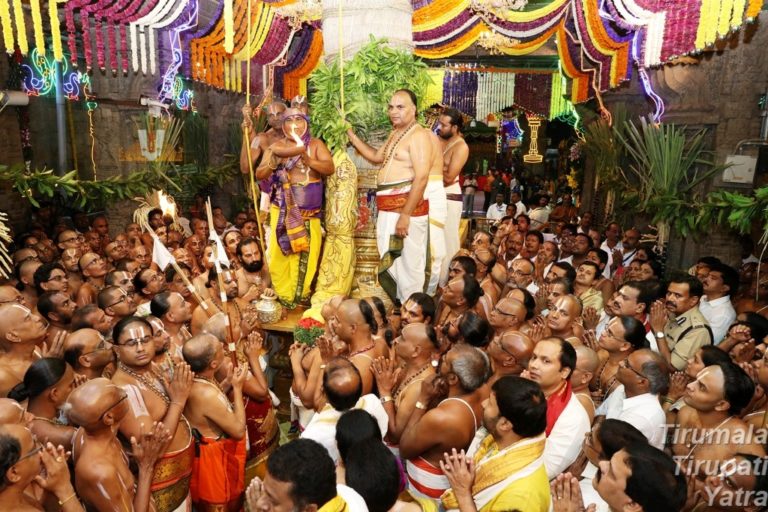
Dwajarohanam
Malayappa Swamy along with Sridevi and Bhudevi
During the car services of Brahmotsavas, Malayappa Swamy along with Sridevi and Bhudevi goes in procession in the streets around the temple of Tirumala on
- Pedda Seshavahana
- Muthyala Pandiri
- Kalpavrikshavahana
- Sarvabhupalavahana
- Suvarnavahana
- Rathotsava
- Bangaru Tirucchi [palanquin].
Glory of Lord
Tallapaka Annamacharya describes the glory of Sri Venkateswaraswamy’s festival, vividly:
In the streets of Tirumala, glittered the God of gods, With beauty, indescribably great,
- With bearers, on a palanquin, the first day
- In luxury on Sesha, the second day
- On the third day, sportively under a pearl bower
- Duly on the fourth, in a flowery temple
- Swiftly, on Garuda, on the fifth day
- On the sixth, mounting the elephant
- On the seventh, on Suryaprabha, immaculately
- On the eighth, a traditional horse carrier
- On the ninth, on a golden palanquin
- On the tenth, united on a wedding seat
With Alamelmanga and on cars, amidst consorts.
No Fireworks for Brahmotsavams now
After the descent of the flag, the festive idols are given naivedya, nirajana and other services. After that the priests and religious teachers are honoured. Then Lord Malayappa reaches Ranganayaka’s temple premises along with Sridevi and Bhudevi.
These festive idols stay back in the temple premises of Ranganayaka from the beginning of Brahmotsavas till Diwali, leaving Ananda Nilaya and the Prime idol of the Lord.
At one time, there were fireworks during the Brahmotsavas. Now-a-days, we don’t have this.
At 6.00 O’ clock in the evening, during the Brahmotsavas before the night festivities, amidst the lighting of a thousand lamps, the Swing Festival [Uyyala Seva] of Lord Malayappa accompanied by Sridevi and Bhudevi is celebrated outside the Tirumala temple in the courtyard of the Lord in the South East. The lord manifests himself to the devotees, delighting their sight.
Only Malayappa swamy
Malayappa swamy alone goes in procession in the temple streets of Tirumala on
- Chinna Seshavahana
- Hamsavahana
- Simhavahana
- Mohiniincarnation palanquin
- Garudavahana
- Hanuman's vahana
- Gajavahana
- Suryaprabha
- Chandraprabha
- Aswavahana.
The Flag descends - Dhwajavarohana
On the ninth night of the Brahmotsavas, the festival of Dhwajavarohana takes place in the temple. In the presence of Lord Malayappa accompanied by Sridevi and Bhudevi, while Vedic scholars chant the scriptures, with instruments playing, with drums beating, bidding farewell to Brahma and other gods as well as the lords of the directions, the flag of Garuda is made to descend from the flag post.
Thus the Brahmotsavas that starts with the hoisting of the flag of Garuda inviting Brahma and other gods besides the Lords of Directions, concludes with the descent of the same flag and bidding farewell.
Tallapaka Annamacharya describes the endearing farewell by Lord Srinivasa to Brahma and other gods as well as the lords of the directions in the most natural vein.
Adieu, Lords—go and come back
Quickly again for the next festivities
Hara and Brahma, go and come back
Again for the festival next
You also gods, saints and Brahmins, go
And come back
You are tired all these days
Yama, go and come back, go with the moon
Come happily again with gods,
Go, you lords of directions
You, who are tired with a labour of love
Narada, Sanaka and Sanandana, you also
Go happily, but do not go too far
Come again. Serve me on these seven hills.
Glimpse
- Kalpa Vriksha vahanam is a procession of the idol placed under a gilt wooden tree. Andolika vahanam is a procession attending his excellency in a palanquin
- SeshaVahanam is the God carried forth on a gilt serpent Sesha.
- Sarva Bhoopala Vahanam signifies the carrying the idol on a gilt throne.
- Surya Prabha Vahanam is a procession of the idol attended by gilt Sun.
- Addala ara (Mandapamu) is a trip of the gentleman to a room surrounded by looking glasses adjusted to reflect him several times.
- Andolika Vahanam is another kind of palanquin procession. For all the above the votary who gives the idol the trouble of coming out is forty rupees less rich than he was before.
- Garuda Vahanam is a procession in which the idol is mounted on a gift parrot.
- Chandra Prabha is a procession of the idol accompanied by a gilt moon.
- Hanuman Vahanam is a procession of the idol mounted upon a gilt figure like an elephant.
- Simha Vahanam is the last procession in which the idol rides on a gilt lion.
- Bala Sesha Vahanam is the last procession of the idol sitting upon a gilt serpent.
Know about Vahanams and Importance
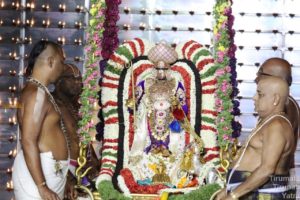
Aswa Vahanam
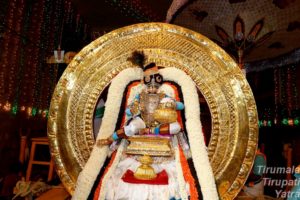
Chandra Prabha Vahanam
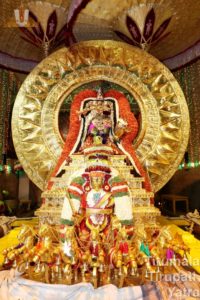
Surya Prabha Vahanam
